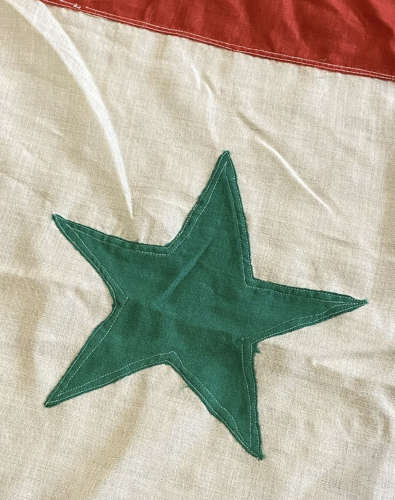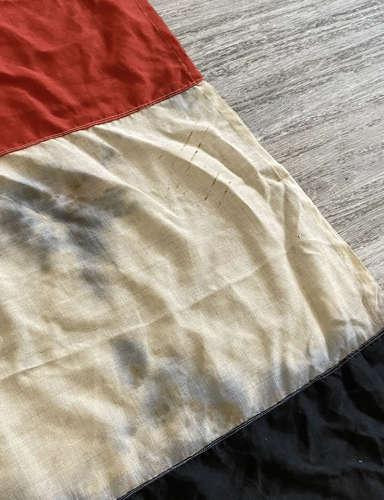







Syrian Conflict United Arab Republic 1958-61 Large Gov Military Flag
Code: 13144
For sale is a rare Syrian Conflict 1958-1961 United Arab Republic Huge Syrian Government Building Flag. This huge flag measures height 134cms x 274cms length. This rare flag was used on government buildings, military camps and other important buildings. Overall the flag is in good condition, has its original wooden toggle, rope and is a quality made double sided flag four panel constructed flag. Unfortunately there is small damage to the right hand corner which can be seen in the photos and a few ink water run stains on the white.
Relevant History of the United Arab Republic:
The flag of the United Arab Republic (UAR - Egypt and Syria) was red-white-black with two green stars. Syria left in 1961, but Egypt kept the UAR name and flag until the 31 December 1971.
The United Arab Republic (UAR; Arabic: الجمهورية العربية المتحدة, romanized: al-Jumhūrīyah al-'Arabīyah al-Muttaḥidah) was a sovereign state in the Middle East from 1958 until 1971. It was initially a political union between Egypt (including the occupied Gaza Strip) and Syria from 1958 until Syria seceded from the union after the 1961 Syrian coup d'état. Egypt continued to be known officially as the United Arab Republic until 1971.
The republic was led by Egyptian President Gamal Abdel Nasser. The UAR was a member of the United Arab States, a loose confederation with the Mutawakkilite Kingdom of Yemen, which was dissolved in 1961.
The United Arab Republic was established on 1 February 1958 as the first step towards a larger pan-Arab state, originally being proposed to Egyptian President Gamal Abdel Nasser by a group of political and military leaders in Syria.
Pan-Arab sentiment traditionally was very strong in Syria, and Nasser was a popular heroic figure throughout the Arab world following the Suez Crisis of 1956. There was thus considerable popular support in Syria for union with Nasser's Egypt. The Arab Socialist Ba'ath Party was the leading advocate of such a union.
In mid-1957, Western powers began to worry that Syria was close to a Communist takeover; it had a highly organized Communist Party and the newly appointed army's chief of staff, Afif al-Bizri, was a Communist sympathizer. This caused the Syrian Crisis of 1957 after which Syrians intensified their efforts to unite with Egypt. Nasser told a Syrian delegation, including President Shukri al-Quwatli and Prime Minister Khaled al-Azem, that they needed to rid their government of Communists, but the delegation countered and warned him that only total union with Egypt would end the "Communist threat". According to Abdel Latif Boghdadi, Nasser initially resisted a total union with Syria, favoring instead a federal union. However, Nasser was "more afraid of a Communist takeover" and agreed on a total merger. The increasing strength of the Syrian Communist Party, under the leadership of Khalid Bakdash, worried the Syrian Ba'ath Party, which was suffering from an internal crisis from which prominent members were anxious to find an escape. Syria had a democratic government since the overthrow of Adib al-Shishakli's military regime in 1954, and popular pressure for Arab unity was reflected in the composition of parliament.
When on 11 January 1958 al-Bizri led a Syrian delegation composed of military officers to Cairo, and personally encouraged Syrian-Egyptian unity, Nasser opted for a quick merger. Only Syrian advocates of unity, including Salah al-Din Bitar and Akram El-Hourani had prior knowledge of this delegation; Quwatli and Azem were notified a day later and considered it tantamount to a "military coup".
Nasser's final terms for the union were decisive and non-negotiable: "a plebiscite, the dissolution of parties, and the withdrawal of the army from politics". While the plebiscite seemed reasonable to most Syrian elites, the latter two conditions were extremely worrisome. They believed it would destroy political life in Syria. Despite these concerns, the Syrian officials knew it was too late to turn back. The members of the elite in Syria viewed the merger with Egypt as the lesser of two evils. They believed that Nasser's terms were unfair, but given the intense pressure that their government was undergoing, they believed that they had no other choice.
A plebiscite was held on February 21, 1958, with Egyptians and Syrians voting in favor of the merger. The result were announced on February 22 and Nasser was declared the new president of the United Arab Republic.
Egyptian and Syrian leaders signed the protocols, although Azem did so reluctantly. Nasser became the republic's president and very soon carried out a crackdown against the Syrian Communists and opponents of the union which included dismissing Bizri and Azem from their posts.
The UAR adopted a flag based on the Arab Liberation Flag of the Egyptian Revolution of 1952, but with two stars to represent the two parts of the UAR. From 1980 this has been the official flag of Syria. In 1963, Iraq adopted a flag that was similar but with three stars, representing the hope that Iraq would join the UAR. The current flags of Egypt, Sudan and Yemen are also based on the Arab Liberation Flag of horizontal red, white and black bands.
This will be sent via special delivery and dispatched within two working days. Happy to post world wide.
